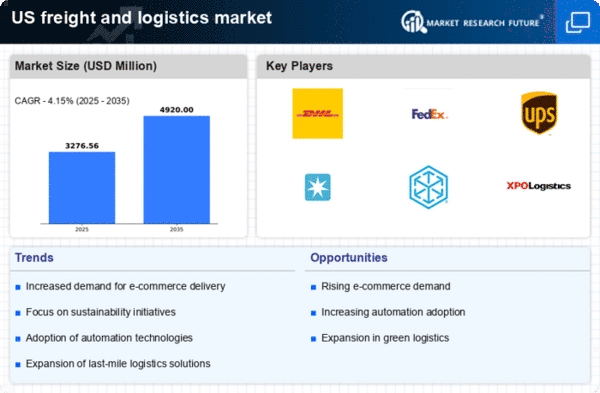Regulatory Changes
Regulatory changes are increasingly influencing the freight and-logistics market. Recent updates to transportation regulations, particularly concerning emissions standards and safety protocols, are reshaping operational practices. The Environmental Protection Agency (EPA) has proposed stricter emissions regulations for heavy-duty trucks, which could necessitate substantial investments in cleaner technologies. Compliance with these regulations may increase operational costs for logistics providers, potentially affecting pricing structures within the freight and-logistics market. However, these changes also present opportunities for companies to innovate and adopt sustainable practices, which could enhance their competitive edge in a market that is progressively prioritizing environmental responsibility.
Labor Market Dynamics
Labor market dynamics play a crucial role in shaping the freight and-logistics market. As of November 2025, the industry faces a notable shortage of skilled labor, particularly in truck driving and warehousing. The American Trucking Associations estimates a shortfall of approximately 80,000 drivers, which could escalate if not addressed. This labor shortage is likely to drive up wages, with average salaries for truck drivers potentially reaching $70,000 annually. Consequently, logistics companies may need to invest in training programs and incentives to attract and retain talent. The evolving labor landscape could significantly impact operational efficiency and service delivery within the freight and-logistics market.
Consumer Demand Shifts
Shifts in consumer demand are significantly impacting the freight and-logistics market. As consumer preferences evolve towards faster delivery options, logistics providers are compelled to adapt their operations. The demand for same-day and next-day delivery services has surged, with 40% of consumers indicating a willingness to pay extra for expedited shipping. This trend is prompting logistics companies to enhance their last-mile delivery capabilities and invest in more efficient distribution networks. Consequently, the freight and-logistics market is likely to see increased competition as companies strive to meet these changing consumer expectations, which could lead to innovations in service offerings and operational strategies.
Infrastructure Investment
The freight and-logistics market is currently experiencing a surge in infrastructure investment across the United States. Government initiatives aimed at enhancing transportation networks, including roads, bridges, and ports, are pivotal. In 2025, federal funding for infrastructure projects is projected to exceed $100 billion, which is expected to bolster the efficiency of freight movement. Improved infrastructure not only reduces transit times but also minimizes operational costs for logistics companies. This investment is likely to enhance the overall capacity of the freight and-logistics market, enabling it to accommodate increasing demand. Furthermore, the integration of smart technologies in infrastructure is anticipated to optimize traffic management and reduce congestion, thereby facilitating smoother operations within the freight and-logistics market.
Technological Advancements
Technological advancements are revolutionizing the freight and-logistics market, driving efficiency and innovation. The adoption of automation, artificial intelligence, and data analytics is transforming supply chain management. In 2025, it is estimated that 30% of logistics operations will incorporate AI-driven solutions, enhancing decision-making processes and optimizing routes. Additionally, the rise of Internet of Things (IoT) devices is facilitating real-time tracking of shipments, improving transparency and customer satisfaction. These technological innovations are likely to reduce operational costs and increase the speed of service delivery, positioning companies favorably within the competitive landscape of the freight and-logistics market.

















Leave a Comment